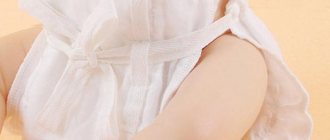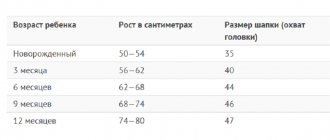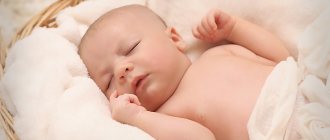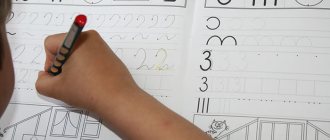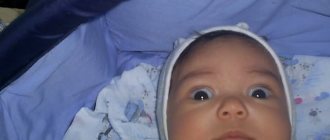Perfect example
Description of knitted overalls for a newborn. We cast on 30 loops with a white thread and knit a length of 8 cm with a 1x1 elastic band. Using blue thread, first cast on 15 loops across the width of the product and plan out the ornament.
It is necessary to draw 11 rows of the pattern, after which the “Houndstooth” is 6 rows high. Then we add 6 loops and knit 10 patterns upward.
On the wrong side of the panties we decrease 5 loops, knit the second row in the same way, and in the next row we also decrease 5 loops. Then we knit the pattern up 8 rows.
The fabric is divided into two parts - we knit the back separately, and the front separately. We make a reduction on the shelf, also at the back. We sew both parts together.
Next we knit the neckline. We cast on 46 loops along the neckline and knit with an elastic band of 2-3 cm, after which we knit a “houndstooth” hood. For symmetry, it is better to add 1 more loop. In total, you get 11 rows of 47 loops of the pattern, and 7 rows to the top.
The next step is to place 7 loops in the middle of the pattern, removing from each side until you reach 7 loops. The next step is to knit the strips with a 1x1 elastic band, freeing the loops of the buttons.
We cast on 62 loops along the hood strip, like shelves. From 1 edge stitch, 2 stitches, 4 rows in stockinette stitch. Front side - alternate between the front side, yarn over...
The wrong side is the wrong side, we knit the yarn over, we get an end-to-end circle. Then 4 rows in stockinette stitch and then according to the pattern.
Sleeves - you can’t live without them. We cast on 30 loops and knit the cuffs with a 1x18 elastic band. Raise the pattern by 9 rows, width - 7. Sew on the sleeves, make pompoms, sew on buttons. And voila, the jumpsuit is ready!
We hope the reader liked the knitting pattern for overalls for a newborn.
LiveInternetLiveInternet
Set for a baby Set for a baby, I knitted a blouse, based on the description of a pink blouse.
Translation from here And here is my translation: Size: 0-3 months. Material: 3 skeins of 50 g. James C.Brett Rainbow Double Knit (100% acrylic) hook No. 4 and 5 3 buttons 5 m of satin ribbon, 6 mm wide Sample: 9 tbsp. s n. and 4 rows = 5 x 5 cm Decrease: leave the last stitch of each st. on the hook, make a yarn over and pull the thread through all 3 sts. “Shell” pattern: 2 tbsp. with 2 n., 1 air. p., 2 tbsp. s n. Fork pattern: 1 tbsp. with 2 n., 1 air. p., 1 tbsp. s n. Finishing the picot edge: * 2 9 tbsp. with n., 3 air. p., 1 tbsp. s n. in 1st of 3 air. p., skip 1 tbsp. s n. *, repeat from * to * Neckline Using crochet hook No. 4, cast on 55 sts. Row 0: 1 tbsp. from 2 n. in the 4th st from the hook, 1 tbsp. from 2 n. in each p. to the end (= 52 stitches + 3 chain stitches) 1st row: (Inc.) 3 chain stitches. p., 1 tbsp. from 2 n. next Art., * 2 tbsp. from 2 n. next tbsp., 1 tbsp. from 2 n. in each from the following 4 tbsp. *, repeat from * to * until the end, 1 tbsp. from 2 n. to the top of 3 stitches. Turn (= 62 stitches + 3 chain stitches). 2nd row: 3 air. p., 1 tbsp. from 2 n. next tbsp., 1 tbsp. from 2 n. in each Art. to the end, 1 tbsp. from 2 n. to the top of 3 sts. Turn. 3rd row: (Increase) 3 air. p., 1 tbsp. from 2 n. next Art., * 2 tbsp. from 2 n. next tbsp., 1 tbsp. from 2 n. in each from the following 3 tbsp. *, repeat from * to * until the end, 1 tbsp. from 2 n. to the top of 3 stitches. Turn (= 77 stitches + 3 chain stitches). 4th row as 2nd row 5th row: (Increase) 3 air. p., 1 tbsp. from 2 n. next Art., * 2 tbsp. from 2 n. next tbsp., 1 tbsp. from 2 n. in each from the following 2 tbsp. *, repeat from * to * until the end, 1 tbsp. from 2 n. to the top of 3 stitches. Turn (= 102 stitches + 3 chain stitches). 4th row as 2nd row 7th row: (Inc) as 5th row until 1 stitch remains. from 2 n. and 3 air. p., 2 tbsp. from 2 n. 1 tbsp, 1 tbsp. from 2 n. to the top of 3 stitches (= 136 stitches + 3 chain stitches). Bottom 1st row: 3 air. p., * skip 1 tbsp., 1 shell next. tbsp., skip 1 tbsp., 1 tbsp. s n. next Art. *, repeat from * to * until 3 tbsp remain. from 2 n. and 3 air. p., skip 1 tbsp., 1 shell next. tbsp., skip 1 tbsp., 1 tbsp. from 2 n. to the top of 3 stitches (= 34 shells). To turn. 2nd row: 3 air. p., * 1 plug in air. p. shells, 1 tbsp. from 2 n. in Art. s n. *, repeat from * to * until 1 shell and 3 air remain. n., 1 plug in air. p. shells, 1 tbsp. from 2 n. to the top of 3 sts. Turn. 3rd row: 3 air. n., * 1 shell per fork, 1 tbsp. s n. next Art. *, repeat from * to * until 1 fork and 3 air remain. n., 1 shell per fork, 1 tbsp. from 2 n. to the top of 3 sts. Turn. 4th row: (divide for armholes) 3 air. p., * 1 plug in air. p. shells, 1 tbsp. from 2 n. in Art. s n. *, repeat from * to * 3 more times, 1 fork in the air. p. shells, 2 tbsp. from 2 n. in Art. s n., skip 7 shells, 2 tbsp. from 2 n. next Art. with n., * 1 fork in air. p. shells, 1 tbsp. from 2 n. in Art. s n. *, repeat from * to * 8 more times, 1 fork in the air. p. shells, 2 tbsp. from 2 n. in Art. s n., skip 7 shells, 2 tbsp. from 2 n. next Art. with n., * 1 fork in air. p. shells, 1 tbsp. from 2 n. in Art. s n. *, repeat from * to * 3 more times, 1 fork in the air. p. shells, 1 tbsp. from 2 n. to the top of 3 sts. Turn. 5th row: 3 air. n., * 1 shell per fork, 1 tbsp. s n. next Art. *, repeat from * to * 4 more times, 1 shell in the armhole chain between sts. from 2 n., 1 tbsp. s n. next Art., repeat from * to * until 1 fork and 3 air remain. n., 1 shell per fork, 1 tbsp. from 2 n. to the top of 3 sts (= 22 shells). To turn. Repeat rows 2 and 3 for a total of 8 shell rows. Sleeves Row 1: With the wrong side facing you, join the thread in the same st. s n. from 2 tbsp. from 2 n. and 1 air. p. at the base of the armhole, 3 air. n., * 1 fork in shell, 1 tbsp. from 2 n. in Art. s n. *, repeat from * to * 5 more times, * 1 fork into the shell, 1 tbsp. from 2 n. in the same article s n. same as 2 tbsp. from 2 n. at the base of the armhole. (= 7 forks). To turn. 2nd row: 3 air. n., * 1 shell per fork, 1 tbsp. s n. next Art. *, repeat from * to * until 1 fork and 3 air remain. n., 1 shell per fork, 1 tbsp. from 2 n. to the top of 3 sts. Turn. Repeat the rows of the pattern, first 1 row with forks, then 1 row with shells 2 more times. Track. row: 1 air. p., 1 tbsp. s n. to the base of the air. p., * skip 1 tbsp., 1 tbsp. s n. next tbsp., 1 tbsp. s n. in a shell, 1 tbsp. s n. next tbsp., skip 1 tbsp., 1 half tbsp. from 2 n. next Art. *, repeat from * to * until the last shell, skip 1 tbsp., 1 tbsp. s n. next tbsp., 1 tbsp. s n. in a shell, 1 tbsp. s n. next tbsp., skip 1 tbsp., 1 tbsp. s n. to the top of 3 sts (= 29 sts). To turn. Track. row: 1 air. p., 1 tbsp. s n. to the base of the air. p., 1 tbsp. s n. next Art., * 2 air. p., skip 1 tbsp., 1 tbsp. s n. next 2 tbsp. *, repeat from * to * to the end. To turn. Track. row: 1 air. p., 1 tbsp. s n. in each loop to the end (= 29 stitches). To turn. Repeat last row 2 more times. Track. row (“pico”): 1 air. p., 1 tbsp. s n. to the base of the air. p., 1 tbsp. s n. next Art., * 3 air. p., 1 tbsp. s n. in the 1st of 3 p., skip 1 tbsp., 1 tbsp. s n. next 2 tbsp. *, repeat from * to * to the end. Finish. Finishing Sew the sleeves. Starting from the bottom edge with the right side facing you, use crochet number 4 to knit 1 row of st. s n. evenly along the right edge, around the neckline and along the left edge (3 treble stitches in corner loops). To turn. Track. row: 1 air. p., 1 tbsp. s n. in each Art. to the neck. To turn. Track. row: finishing the edge with a picot pattern to the end. Finish. Do the same for the other edge of the shelf. Finish. Hide the ends. Sew buttons. Thread a ribbon through each. 2 tbsp. from 2 n. around the yoke and at the bottom of the sleeves. Decorate with roses and bows.
bigpic=
Variety of children's overalls
In fact, today the choice of knitted baby onesies for newborns is quite diverse. After all, they say that demand creates supply.
A huge selection - with a hood, without a hood, with ears, with socks, without socks, from various threads. In order to choose the perfect overalls for your baby, the expectant mother needs to learn how to knit it herself, just a matter of...
Another model for a little child
So, let’s learn, try and knit a jumpsuit with ears for a newborn with our own hands. We bring to your attention an interesting children's sample.
And an important tip: in order for your baby to wear the onesie for at least 2-3 months, knit it in a slightly larger size.
NOTE!
How to knit a shirtfront simply and beautifully with knitting needles for children, women and men: useful tips and instructions (80+ photos)- Knit a tunic - simple patterns and recommendations for choosing models for children and adults (130 photos)
Jacquard knitting patterns: knitting patterns and tips for choosing the best patterns for beginners and professionals (115 photos)
Height 56 cm. This winter example is best knitted from wool yarn, you will need 150 g of it.
Pants. We cast on 56 loops and knit with an English elastic band of 1.5 cm. Add 1 loop and perform the next 10 cm with the main pattern. On the side of each trouser leg we add 1 loop through three rows only 2 times.
Back. We combine the loops of the back legs and smoothly move into the back. From the very beginning, we decrease 2 loops on both sides. Now we remove 1 loop 6 times every row. We must get the width of the canvas to be 39 cm, then we make the shoulders.
We close 5 loops on each side. Next, through the row we remove 5, 4, 5 and 6 stitches. The rest when the width of the canvas reaches 40.5 cm.
Before. The front of the panties is knitted using the above method. Add 3 loops between the legs. Then we knit 18 cm according to the pattern. Clasp. Place 21 loops in the middle. We knit the remaining ones separately, remembering the bevels. We knit the central loops and close them off.
NOTE!
How to knit a rug - detailed instructions and diagrams on how to properly knit a neat, beautiful rug- Knit a men's sweater: step-by-step instructions on how to quickly and easily knit a sweater with your own hands (80 photos)
How to knit socks - step-by-step description and recommendations on how to knit warm socks correctly and quickly (85 photos)
Sleeves. First, the elastic is 1.5 cm. On the next 10th row, a loop is added - 3 times, then three loops every 8 rows.
Now all that remains is to assemble the overalls and sew on the buttons.
A master class on crocheting children's overalls is ready
I had the idea of doing a master class in this format for a long time.
He's not quite ordinary. Here you will not find a specific name for the yarn, how many loops to cast on and how many rows to knit (or rather, you will find one size for Jeans yarn from Yarn Art), but you will gain a large amount of knowledge, thanks to which you yourself will answer the questions: 1. How to calculate the knitting density. 2.What measurements are needed for knitting a jumpsuit? 3.How to take measurements and how to apply them. And also other questions, after answering which you will be able to knit not only this jumpsuit, but also many other wonderful things. In this tutorial I tell you how to simply and beautifully knit a square yoke with a raglan top with a round neckline and dropped shoulders, calculate the required number of loops for your size, calculate the loops when moving from one pattern to another, make increases and decreases symmetrically, etc.
The master class is designed for both beginners in knitting and those who knit confidently. I would like to draw your attention to the fact that this model of overalls looks equally good both from spring-summer yarn and from autumn-winter, warm yarn. Those. this pattern can be knitted for any season)
For warm overalls, this is wool blend (merino wool) with an average thickness of 320-380m per 100g.
For the demi-season option: cotton with acrylic, for example, “Jeans” yarn from YarnArt or “Kotongold” Alize, etc. Composition: 55% cotton 45% acrylic (percentage may be slightly different). Meterage 160-200 m per 50 g.
For the summer option, it is better to choose not cotton, but cotton with viscose. The yarn should be soft.
Yarn consumption is up to 350-450 g, but this is individual, depending on the size of the overalls, the yarn (its texture), and the individual knitting density.
The photo shows a jumpsuit knitted with Novelty yarn from Vita, size 52-56 (newborn)
The photo shows a jumpsuit knitted with Jeans yarn from Yarn Art, size 68-74 (using his example, we disassemble the jumpsuit in MK)
As you can see from the photographs, the texture of the overalls is different, but they look equally elegant.
The master class was compiled by me based on what I did online. In it, each participant knitted a jumpsuit according to his own measurements, from yarn chosen independently. The appearance of the overalls turned out to be both the same and different))))
I would also like to note that there are very few models of christening clothes for boys on the Internet, and this model of overalls was originally conceived specifically for these purposes.
You will not find 90% of the information that I give in this master class on the Internet, these are my personal developments, diagrams, descriptions. The remaining 10% is information on the sizes of children's clothing, but it is also organized and adapted specifically for this master class.
Let me summarize what I wrote above:
— This master class provides high-quality and unique information on the technique of crocheting children's overalls.
— The jumpsuit model looks equally good in both summer and winter yarn.
— In the white version, this jumpsuit model is ideal for a boy’s christening outfit.
— Depending on the yarn, color scheme and decor, everyone will get their own original jumpsuit.
— According to my MK, you can knit things for sale in unlimited quantities.
For a master class on knitting similar booties, see my blog:
A master class on the technique of crocheting children's overalls can be purchased in my store:
I wish everyone easy loops and a good mood!
A few final tips
Firstly, the dimensions of a knitted overalls for newborns should be slightly larger than the actual height of the baby.
Secondly, if you want to dress your baby warmer, acrylic threads with a small percentage of wool are suitable, so as not to cause allergies, and in the summer - cotton.
Thirdly, convex patterns will bring discomfort to the baby, because his body is very tender and fragile and reacts literally to everything.
NOTE!
- Knit an openwork scarf - step-by-step description and knitting or crocheting pattern (110 photos and videos)
How to knit a sleeveless vest - how to knit the most fashionable models of 2021 with your own hands. 120 photos and a step-by-step master class on knitting sleeveless vests
Knitting from mohair: advantages of the material, patterns, patterns and description of yarn (85 photos)
And, remember, maybe your job will not be as attractive as that of professionals (especially if this is your first job, in principle), but for your baby it is ideal because it is connected with love!
How to choose yarn and knitting method
When it comes to children's things, you can't skimp! A knitted item will turn out cheaper than a store-bought one, so it’s better to choose yarn of excellent quality. For newborns, cotton or soft wool threads are suitable; a small acrylic content is allowed. The main thing is to check when purchasing that the yarn is pleasant to the touch and does not prick.
The color scheme can be absolutely any, the one that is pleasant to mommy, but it is better to leave too bright acidic colors on the store shelf. If low-quality dyes were used, the product may cause allergies in the baby and the work will go down the drain.
A lot depends on the knitting method and the chosen pattern. The same model can be knitted in different ways, and the finished items will be completely different from each other. In addition, if you choose an openwork knit, then such a product will look great in the summer, and a tight-knit jumpsuit will warm the baby in the winter and in mid-season weather.


